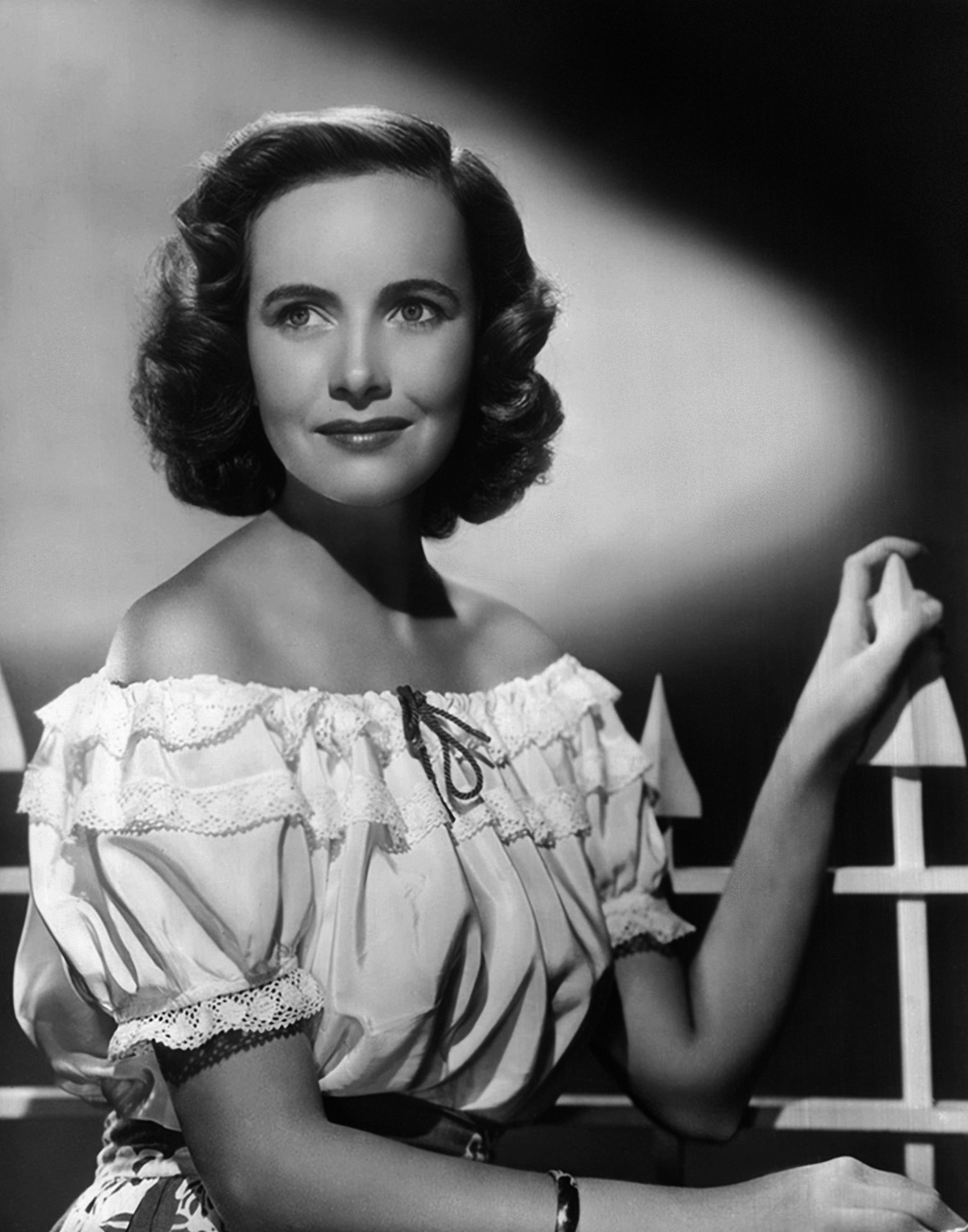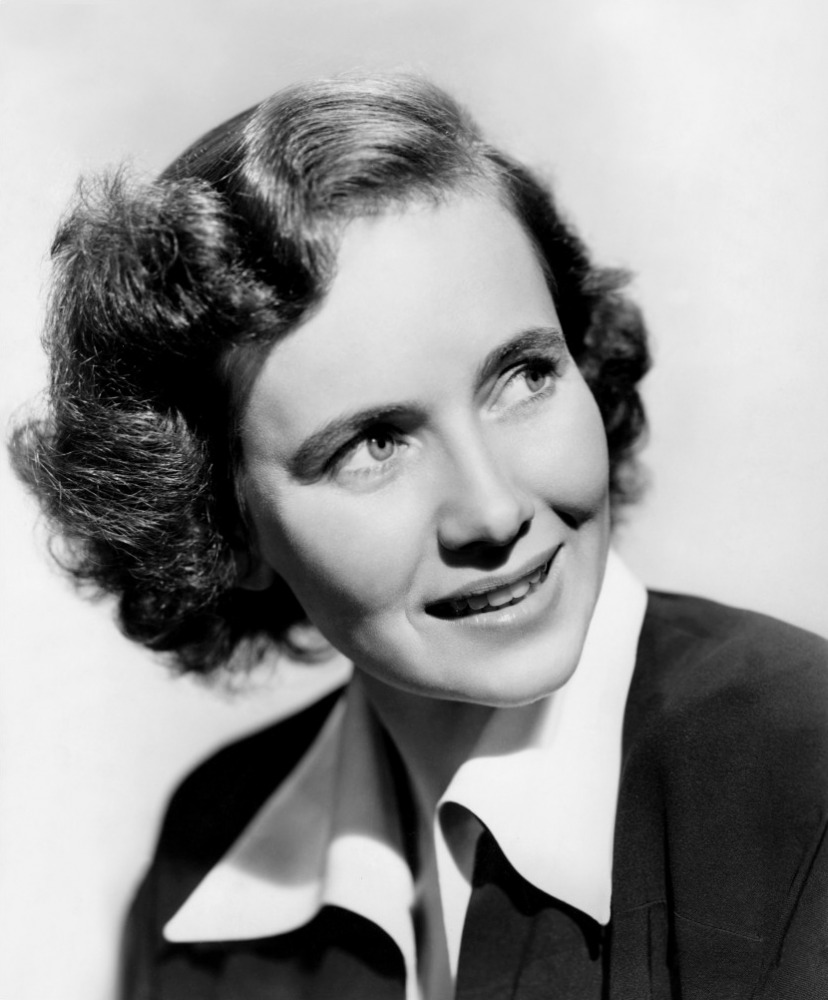Teresa Wright (Muriel Teresa Wright)

Muriel Teresa Wright was born on October 27, 1918 in Harlem, New York City, the daughter of Martha (née Espy) and Arthur Wright, an insurance agent. Her parents separated when she was young. She grew up in Maplewood, New Jersey, where she attended Columbia High School. After seeing Helen Hayes star in Victoria Regina at the Broadhurst Theatre in New York City in 1936, Wright took an interest in acting and began playing leading roles in school plays. She earned a scholarship to the Wharf Theater in Provincetown, Massachusetts, where she was an apprentice for two summers. Following her high school graduation in 1938, she went to New York, changed her name to “Teresa Wright”, and was hired as understudy to Dorothy McGuire and Martha Scott for the role of Emily in Thornton Wilder’s stage production of Our Town at Henry Miller’s Theatre. She took over the role when Scott left for Hollywood to film the on-screen version of the play. In 1941, Wright was nominated for the Academy Award for Best Supporting Actress for her film début in The Little Foxes. The following year, she was nominated again, this time for Best Actress for The Pride of the Yankees, in which she played opposite Gary Cooper as the wife of Lou Gehrig. That same year, she won the Academy Award for Best Supporting Actress as the daughter-in-law of Greer Garson’s character in Mrs. Miniver. Wright is one of only nine players who have been nominated in both categories in the same year. Her three Academy Award nominations and one Academy Award in her first three films remains a rare accomplishment. She remains the only performer to have received Academy Award nominations for her first three films. In 1943, Wright appeared in the acclaimed Universal film Shadow of a Doubt, directed by Alfred Hitchcock, playing an innocent young woman who discovers her beloved uncle (played by Joseph Cotten) is a serial murderer. Hitchcock thought Wright was one of the most intelligent actors he had worked with, and through his direction brought out her vivacity, warmth, and youthful idealism—characteristics uncommon in Hitchcock’s heroines. In 1946, Wright delivered another notable performance in William Wyler’s The Best Years of Our Lives, an award-winning film about the adjustments of servicemen returning home after World War II.
Four years later, she would appear in another story of war veterans, Fred Zinnemann’s The Men (1950), which starred Marlon Brando in his film début. In 1947, Wright appeared in the western Pursued opposite Robert Mitchum. The moody “Freudian western” was written by her first husband Niven Busch. The following year, she starred with David Niven, Farley Granger, and Evelyn Keyes in Enchantment, a story of two generations of lovers in parallel romances. Wright received glowing reviews for her performance. Newsweek commented, “Miss Wright, one of the screen’s finest, glows as the Cinderella who captivated three men.” And The New York Times concluded, “Teresa Wright plays with that breathless, bright-eyed rapture which she so remarkably commands.” In December 1948, after rebelling against the studio system that brought her fame, Teresa Wright had a public falling out with Samuel Goldwyn, which resulted in the cancellation of Wright’s contract with his studio. In a statement published in The New York Times, Goldwyn cited as reasons her refusal to publicize the film Enchantment, and her being “uncooperative” and refusing to “follow reasonable instructions.” In her written response, Wright denied Goldwyn’s charges and expressed no regret over losing her $5,000 per week contract. Years later, in an interview with The New York Post, Wright recalled, “I was going to be Joan of Arc, and all I proved was that I was an actress who would work for less money.” For her next film, The Men (1950), instead of the $125,000 she had once commanded, she received $20,000.
In the 1950s, Wright appeared in several unsuccessful films, including The Capture (1950), Something to Live For (1952), California Conquest (1952), The Steel Trap (1952), Count the Hours (1953), The Actress (1953), and Track of the Cat (1954) opposite Robert Mitchum again. Despite the poor box-office showing of these films, Wright was usually praised for her performances. Toward the end of the decade, Wright began to work more frequently in television and theatre. She received Emmy Award nominations for her performances in the Playhouse 90 original television version of The Miracle Worker (1957) and in the Breck Sunday Showcase feature The Margaret Bourke-White Story (1960). In 1955 she played Doris Walker in The 20th Century-Fox Hour remake of the 1947 classic film, Miracle on 34th Street, opposite MacDonald Carey and Thomas Mitchell. On February 8, 1960, Wright was inducted to the Hollywood Walk of Fame with two stars: one for motion pictures at 1658 Vine Street and one for television at 6405 Hollywood Boulevard. In the 1960s, Wright returned to the New York stage appearing in three plays: Mary, Mary (1962) at the Helen Hayes Theatre in the role of Mary McKellaway, I Never Sang for My Father (1968) at the Longacre Theatre in the role of Alice, and Who’s Happy Now? (1969) at the Village South Theatre in the role of Mary Hallen. During this period, she also toured throughout the United States in stage productions of Mary, Mary (1962), Tchin-Tchin (1963) in the role of Pamela Pew-Picket, and The Locksmith (1965) in the role of Katherine Butler Hathaway. In addition to her stage work, Wright made numerous television appearances throughout the decade, including episodes for The Alfred Hitchcock Hour (1964) on CBS, Bonanza (1964) on NBC, The Defenders (1964, 1965) on CBS, and CBS Playhouse (1969). In 1975, Wright appeared in the Broadway revival of Death of a Salesman, and in 1980, appeared in the revival of Morning’s at Seven, for which she won a Drama Desk Award as a member of the Outstanding Ensemble Performance. In 1989, she received her third Emmy Award nomination for her performance in the CBS drama series Dolphin Cove.
Wright’s later film appearances included a major role in Somewhere in Time (1980), the role of the grandmother in The Good Mother (1988) with Diane Keaton, and the role of Miss Birdie in John Grisham’s The Rainmaker (1997), directed by Francis Ford Coppola. In her last decade, Wright lived quietly in her New England home in the town of Bridgewater, Connecticut in Litchfield County, appearing occasionally at film festivals and forums and at events associated with the New York Yankees. In 1996, she reminisced about Alfred Hitchcock at the Edinburgh International Film Festival, and in 2003, she appeared on the Academy Awards show in a segment honoring previous Oscar-winners. Teresa Wright died on March 6, 2005 of a heart attack at Yale-New Haven Hospital in Connecticut at the age of 86. She is buried in Evergreen Cemetery in New Haven.
Born
- October, 27, 1918
- USA
- Harlem, New York
Died
- March, 06, 2005
- USA
- New Haven, Connecticut
Cause of Death
- heart attack
Cemetery
- Evergreen Cemetery
- New Haven, Connecticut
- USA
Other
- Body donated to medical science.



